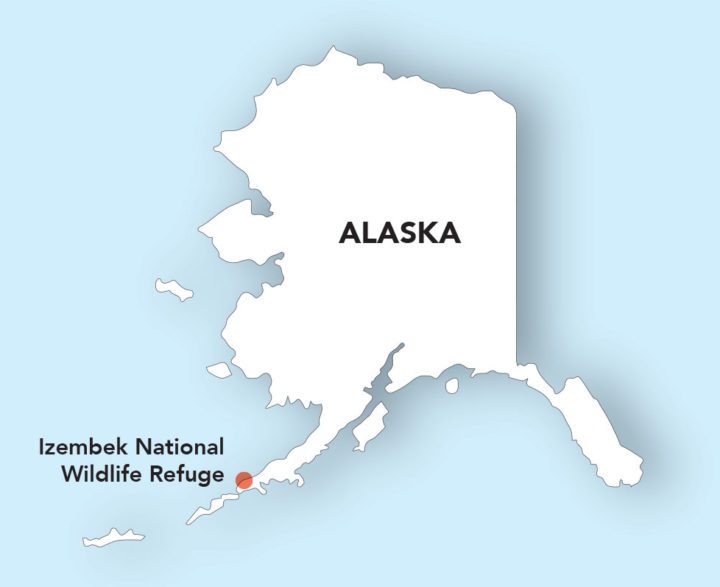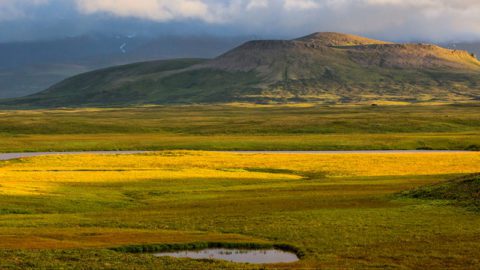Analysis: Should There Be a Road Through the Izembek National Wildlife Refuge?
By Lyle Laverty
Scarred wilderness: Tire tracks mark illegal ATV activity from a nearby road into Izembek. Photo by Gerrit Vyn. June 22, 2020From the Summer 2020 issue of Living Bird magazine. Subscribe now.
The Izembek National Wildlife Refuge lies where the Alaskan Peninsula meets the Aleutian Islands—home ground for millions of seabirds, grizzly bears, and caribou. With a 150-square-mile lagoon and a system of tidal channels, mud flats, wetlands, and freshwater lakes, Izembek is one of the world’s most important migratory bird habitats. Here some of the world’s largest eelgrass beds draw hundreds of thousands of migratory waterfowl from across the Pacific Flyway, including virtually the entire global population of Pacific Black Brant, Taverner’s Cackling Goose, and Emperor Goose.
Izembek has long been recognized as one of the most ecologically unique areas in Alaska. It’s been federally protected since President Eisenhower established the Izembek National Wildlife Range in 1960. Two decades later about three-fourths of Izembek gained the highest level of protection—federally designated wilderness—when the Alaska National Interest Lands Conservation Act became law. These wilderness protections are important; however, they haven’t stopped real threats to Izembek and its precious habitats.


For nearly four decades there have been various proposals to build a road through the refuge. Residents of King Cove, a nearby city, have pressed to develop a road to Cold Bay and its airport for personal, medical, and commercial purposes. King Cove is also home to America’s largest salmon cannery, Peter Pan Seafoods, which is wholly owned by the Japanese company Maruha Capital Investment, Inc. Residents today claim the road is necessary for medical emergencies. With a road in place, Peter Pan would gain a cheaper overland route for transporting fresh product to Cold Bay for export, rather than shipping it by boat to Cold Bay.
Several times the Izembek road proposal has come before the Department of Interior and U.S. Fish and Wildlife Service for review, and every time extensive analyses have reached the same conclusion—a road blazed through Izembek would cause long-term damage to the refuge’s unique habitats and major impacts to its wilderness values. The USFWS issued such assessments in 1980; in 1985, when it stated “vehicular traffic and intensified human use could alter migration patterns” of the “nearly 6,000 to 7,000 caribou that migrate through the isthmus” between wintering and calving grounds; in 1996; and in 1998, when the USFWS found the road proposal was “the greatest known potential threat to wildlife and wilderness values within the Izembek complex.”


In 2008 in my role as an assistant secretary in the U.S. Department of the Interior I visited Izembek and traveled by hovercraft to a meeting in King Cove with community leaders. Having visited the site of the proposed road location through the refuge, I understand the impacts a road would have on the wildlife habitat and wilderness values of the refuge. In 2009, Congress directed the Secretary of the Interior to determine whether a land exchange for road construction was in the public interest. Following a four-year assessment and analysis, Secretary Sally Jewell concluded again that a road through Izembek would irretrievably damage refuge resources and would not be in the public interest.
But that still wasn’t the end of it. Former Interior Secretary Ryan Zinke pursued a land-exchange proposal to facilitate construction of a road through Izembek, which was struck down in a lawsuit judgment in federal district court in March 2019. Then in July 2019, current Interior Secretary David Bernhardt entered into another agreement to exchange Izembek refuge lands with the King Cove Corporation to facilitate construction of the road, drawing lawsuits by nine environmental groups—including The Wilderness Society and National Audubon Society. On June 2, 2020, E&E News reported that this latest in the line of Izembek road proposals was struck down yet again in the U.S. District Court for Alaska. As of press time, Interior was considering filing an appeal.
Construction of a road through the refuge is unnecessary and would undermine the purpose and intent of The Wilderness Act. The proposed land exchange would be the first “de-designation” of federally protected wilderness lands for the objective of allowing a development project to proceed. To address the community’s medical concerns, Congress in 1977 provided over $37 million in federal funding as an alternative to constructing a road through the refuge. In her 2013 decision, Secretary Jewell stated that there were at least three viable transportation alternatives for the health-care needs of residents of King Cove not requiring the construction of a road. Total construction costs of the road are projected to be as high as $81 million, with annual maintenance costs of $1 million. Given the record, providing access for medical emergencies has never been the reason for the road. The Izembek road proposal keeps coming back because it represents the cheapest route to market for the largest seafood company in the world.
Discover the Izembek National Wildlife Refuge
Izembek has been recognized since its original establishment as an area of national and international significance because of its high value as wildlife habitat, and as a wilderness resource. The paramount conservation goal must be to preserve the ecological integrity and wilderness character of the Izembek Refuge.
The future demands Izembek’s refuge and wilderness area remain wild and free from human developments.
Lyle Laverty was nominated as Assistant Secretary of the Interior for Fish, Wildlife and Parks by President George W. Bush and confirmed by the Senate in 2007. He served in that role until 2009.


All About Birds is a free resource
Available for everyone,
funded by donors like you






